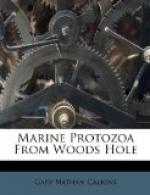Vorticella patellina Mueller. Fig. 59.
Body campanulate, widest at anterior border, from which it tapers directly to the pedicle. The diameter of the peristome is a little larger than the length of the body. The ciliary disk is but little elevated. The cuticle is not striated and the body plasm is quite transparent. Length 52 mu.
[Illustration: Fig. 59.—Vorticella patellina.]
Vorticella marina Greeff. Fig. 60.
The body is conical but variable, and may he short or elongate, so that relative length and breadth offer no chance of identification. In general the body is campanulate. The distinguishing feature is the transverse annulation of the bell.
Small, but common, and grows in small social groups. Length 35 mu.
[Illustration: Fig. 60.—Vorticella marina.]
Genus ZOOTHAMNIUM (Bory de St. Vincent 1824) Stein ’38, ’54.
Colorless and highly contractile forms growing in small or large colonies. The form and structure of the individuals is not different from Vorticella. The colonies are usually richly branched upon the dichotomous plan and the entire colony is contractile. The main character is that with each division of the individual the stalk also divides, each daughter cell getting one-half of the parent stem. The stems therefore remain in communication, so that a simultaneous contraction results, and the colony as a whole is withdrawn. In some species so-called macrogonidia, or larger sexual individuals, are developed alongside the usual ones. Fresh and salt water.
Zoothamnium elegans D’Udekem ’64? Fig. 61.
The bodies are variable—peristomial border widely dilated, tapering and attenuate posteriorly. The pedicle is slender, smooth, and transparent, and branches sparsely at its distal extremity. There are but few zooids (3 to 4). The ciliary disk projects conspicuously beyond the peristomial border. The pharyngeal cleft is very distinct and extends beyond center of body. Length of body 80 mu.
[Illustration: Fig. 61.—Zoothamnium elegans.]
Genus COTHURNIA (Ehr. ’31) Clap. & Lach. ’58.
Colorless forms of medium size-in some cases they may be green by Zoochlorella. The general structure is similar to that of Vorticella, but the individuals are elongate and occupy houses. The macronucleus is invariably long and band-form. The distinguishing character is the colorless or brownish lorica of quite variable form but always attached. These houses may be finger-formed, with widened center, or widened mouth, or constricted mouth, and the like. Ring-formed swellings are frequently developed. Sometimes the mouth becomes twisted and the lorica is therefore bilateral. The houses are attached either directly to some foreign object or by means of a short stalk. The animals are similarly fastened to the lorica, sometimes directly, sometimes by means of a short stalk. When they contract they draw back to the bottom of the lorica; when expanded they usually stretch out of the mouth opening. In some forms there is an operculum, by means of which the opening of the shell can be closed when the animal is retracted. Fresh and salt water.




